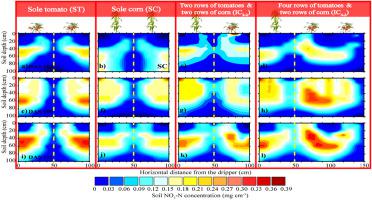Agricultural Systems ( IF 6.6 ) Pub Date : 2022-07-19 , DOI: 10.1016/j.agsy.2022.103461 Ning Chen , Xianyue Li , Jiří Šimůnek , Haibin Shi , Yuehong Zhang , Qi Hu

|
CONTEXT
Intercropping systems have been widely used worldwide due to their high economic benefits and land-use efficiency. While it is well known that inter-species nutrition competition in intercropping systems leads to high production efficiency, the effects of different spatial arrangements of intercropping species on these mechanisms remain unclear.
OBJECTIVE
The objectives of this study were to reveal differences in the soil nitrogen dynamics in the tomato-corn intercropping system with different spatial arrangements of crops and to determine suitable spatial arrangements.
METHODS
A two-year experiment was carried out during the 2018 and 2019 seasons to determine inter-species nitrogen competition in the tomato and corn systems with different spatial arrangements. The treatments included sole corn (SC), sole tomatoes (ST), two rows of tomatoes intercropping two rows of corn (IC2–2), and four rows of tomatoes intercropping two rows of corn (IC4–2) systems. Additionally, the modified HYDRUS (2D/3D) model was used to quantify soil nitrogen concentrations, solute fluxes, soil nitrogen distribution, and soil nitrogen balance in the crop root zone under the SC, ST, IC2–2, and IC4–2 systems.
RESULTS AND CONCLUSIONS
The modified HYDRUS (2D/3D) model could precisely capture the soil nitrogen dynamics with nRMSE ranging from 2.8% to 12.4%. In general, soil NH4-N concentrations in the root zone of tomatoes of different systems decreased as follows: IC2–2 > IC4–2 > ST, while a reverse trend was observed in the root zone of corn. Compared with soil NH4-N, differences in soil NO3-N among different systems were more evident due to its higher mobility. IC2–2 had the highest nitrogen flux, cumulative N flux, N uptake (CNU), and the land equivalent ratio for nitrogen (LERN) among different systems. Among different intercropping systems, the corn's and tomato's highest crop yields occurred in IC2–2 and IC4–2, respectively, with an average of 13,406.0 and 98,732.3 kg ha−1 in both years. Additionally, corn and tomato's highest nitrogen use efficiency (NUE) occurred in IC2–2 and ST, respectively. However, the land-equivalent ratio for nitrogen use efficiency (LERNUE) in IC4–2 was 5.4% higher than in IC2–2. Therefore, IC4–2 is the optimal intercropping system recommended for sustainable agriculture development.
SIGNIFICANCE
The findings of this study improve the understanding of the mechanisms of inter-species nitrogen competition between commercial and grain crops. The study also suggests to the farmers and government suitable spatial arrangements of an intercropping system that can be adopted to promote the development of sustainable agriculture.
中文翻译:

量化不同空间排列的番茄-玉米间作系统中的种间氮竞争
语境
间作系统因其较高的经济效益和土地利用效率而在世界范围内得到广泛应用。虽然众所周知,间作系统中的物种间营养竞争导致高生产效率,但间作物种的不同空间排列对这些机制的影响仍不清楚。
客观的
本研究的目的是揭示不同作物空间排列的番茄-玉米间作系统中土壤氮动态的差异,并确定合适的空间排列。
方法
在 2018 和 2019 季节进行了为期两年的实验,以确定不同空间排列的番茄和玉米系统中的物种间氮竞争。处理包括单一玉米(SC)、单一番茄(ST)、两行番茄间作两行玉米(IC 2 - 2)和四行番茄间作两行玉米(IC 4 - 2)系统。此外,改进的 HYDRUS (2D/3D) 模型用于量化 SC、ST、IC 2 – 2和 IC 4 –下作物根区的土壤氮浓度、溶质通量、土壤氮分布和土壤氮平衡。 2个系统。
结果和结论
修改后的 HYDRUS (2D/3D) 模型可以精确捕捉土壤氮动态,nRMSE范围为 2.8% 至 12.4%。总体而言,不同体系番茄根区土壤NH 4 -N浓度下降趋势为:IC 2 – 2 > IC 4 – 2 > ST,而玉米根区则呈相反趋势。与土壤NH 4 -N相比,土壤NO 3 -N在不同系统间的差异更为明显,因为其迁移率较高。IC 2 – 2具有最高的氮通量、累积氮通量、氮吸收 (CNU) 和氮的土地当量比 ( LER N) 在不同的系统之间。在不同的间作系统中,玉米和番茄的最高作物产量分别出现在IC 2 – 2和IC 4 – 2,两年的平均产量分别为13,406.0 和98,732.3 kg ha -1。此外,玉米和番茄的最高氮利用效率 ( NUE )分别出现在 IC 2-2和 ST。然而,IC 4 – 2中氮利用效率的土地当量比 ( LER NUE )比 IC 2 – 2高 5.4% 。因此,IC 4 - 2是为可持续农业发展推荐的最佳间作系统。
意义
这项研究的结果提高了对经济作物和粮食作物之间物种间氮竞争机制的理解。该研究还向农民和政府建议了间作制度的适当空间安排,可用于促进可持续农业的发展。



























 京公网安备 11010802027423号
京公网安备 11010802027423号